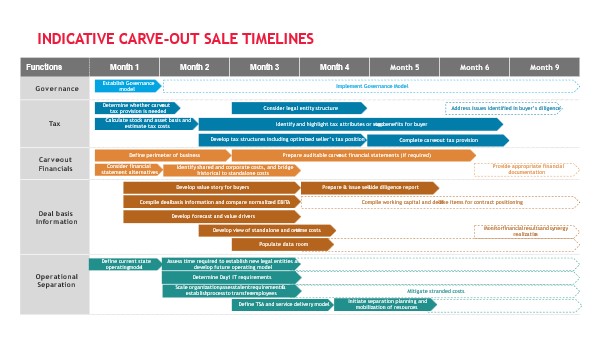Pharmaceutical Carve-Outs in India: Leveraging Strategic Trends for Sustainable Growth
Pharmaceutical Carve-Outs in India: Leveraging Strategic Trends for Sustainable Growth
Authored by: Kunal Gala
The Indian pharmaceutical sector is among the fastest-growing in the world, and this entails increased competition among organisations. Carve-outs are being adopted by many pharmaceutical companies in the country as a strategic measure to maintain a competitive edge, helping companies streamline operations and refocus on core competencies. A key aspect of the present pharmaceutical business is over-the-counter (OTC) products. As this segment is increasingly resembling consumer goods, the operating model and support required for sustained growth are significantly different from the regulated prescription business.
A snapshot of the recent global pharmaceutical separations and carve-outs
| Sr. No | Company | Description | Year of announcement |
| 1 | Sanofi | Announced the demerger of its consumer health business in India into its proposed wholly-owned subsidiary Sanofi Consumer Healthcare India Ltd | 2022 |
| 2 | GSK | De-merged its consumer healthcare business to form Haleon in partnership with Pfizer to continue its focus on vaccines and speciality medicines in line with its global strategy | 2018 |
| 3 | Johnson & Johnson | Announced plans to separate its consumer health business comprising OTC brands like Aveeno, Tylenol, Listerine, Band-aid, etc. The parent company will continue to focus on its pharmaceuticals and medical devices portfolio | 2021 |
| 4 | Merck | Divested its consumer health businesses to P&G for USD 4.2bn | 2018 |
Streamlining Operations and Enhancing Competitiveness
By divesting non-pharmaceutical businesses, companies can focus on their core activities, reduce costs, and enhance efficiency. This enables them to channel efforts into areas where there is a competitive advantage, leading to better product development, manufacturing, and marketing. On-boarding strategic investors as partners in non-pharma businesses helps unlock value and leverage their expertise to expand reach and reduce costs.Allocating Resources to High-Growth Segments
Pharmaceutical OTC brands have strong brand loyalty as general consumer goods but require relatively less regulatory infrastructure than prescription segments. Separating an established non-pharmaceutical business is one of the preferred strategies to unlock value by structuring financial terms to prefer upfront payments. Freed-up resources can then be utilised to support research and development (R&D) and capital expenditure to expand capacity in core operations. Such restructuring can have the potential to significantly re-position the organisations in the market and adapt to evolving customer needs.

Strategic Positioning and Long-term Growth
Three steps are essential for a successful transaction.
1. Clearly define the scope of transaction: Clearly define the scope early on to enables the seller and the buyer to precisely assess synergies, portfolio value, deal terms, and necessary actions during the transition.
The scope should cover products, regions, and the scale of personnel and facilities (e.g., manufacturing) essential to the carve-out. For example, a portfolio of closely related products sharing manufacturing facilities and sales force might be most effectively divested as a single entity. A properly defined scope streamlines the evaluation process and ensures a smooth and successful carve-out.
2.Plan and operate the CarveCo as a standalone business: It is essential to position and operate the carve-out as an independent business before initiating the sale, whenever possible. This ensures a smooth separation with minimal dependencies and helps address potential issues concerning the separation of core functions, such as IT, data management, manufacturing, R&D, commercial, and medical aspects.
For product-level divestments, the focus may mainly be on identifying stand-alone requirements or the current level of support, such as sales force and manufacturing, to support the buyer in planning for the post-carveout phase. The potential acquirer’s analysis is carried out based on the comprehensive financial information made available on a pro forma basis.
Throughout the process of establishing operational independence, the seller should continuously assess the carve-out scope, considering any interdependencies that may arise, such as commercial or operational synergies between products. This evaluation ensures that the carve-out remains aligned with the strategic goals of the seller and potential acquirers.
3. Identify potential buyers or investors: There is a range of possibilities for the future state of CarveCo, from establishing a stand-alone business housed under a separate entity to being acquired by either financial or strategic buyers, with potential integration into another existing entity, or sale of a minority stake to investors and operate as an associate or a subsidiary entity. Evaluating the carve-out's operational independence, product mix, and go-to-market strategy for value creation is essential in formulating hypotheses for a suitable buyer. These hypotheses should consider whether the carve-out would thrive as an operationally independent business or it would be better integrated into the operations of the new owner. Such assessments enable a well-informed decision-making process, aligning CarveCo with the most compatible buyer.
In India’s rapidly evolving pharmaceutical sector, carve-outs have emerged as a strategic trend for companies aiming to achieve sustainable growth and success. Organisation separation is a complex undertaking with multiple dependencies and high impact on future value, and expert support throughout the journey helps in minimising the risks of failure.

